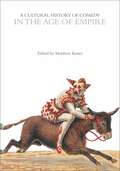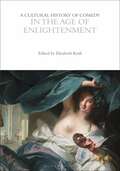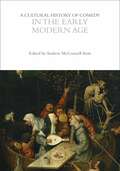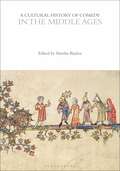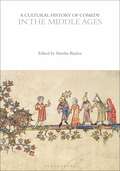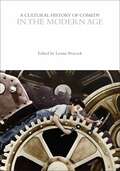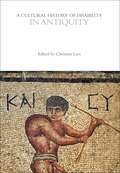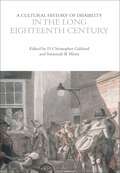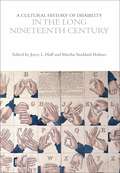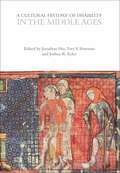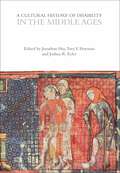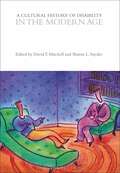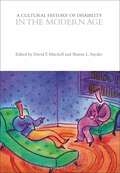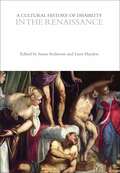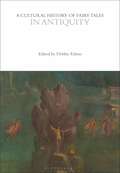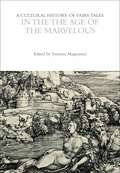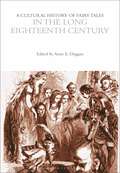- Table View
- List View
A Cultural History of Comedy in the Age of Empire (The Cultural Histories Series)
by Eric Weitz Andrew McConnell StottDrawing together contributions from scholars in a range of fields within 19th- and 20th-century cultural, literary, and theater studies, this volume provides a thorough and varied overview of the many forms comedy took in the 19th century. Given the earth-shattering cultural changes and political events that mark the decades between 1800 and 1920-shifting borders, socioeconomic upheaval, scientific and technological innovation, the rise of consumerism and mass culture, unprecedented overseas expansion by European and American imperial powers-it is no wonder that people in the Age of Empire turned to comedy in order to make sense of the contradictions that structure modern identity and navigate the sociocultural fault lines within modern life. Comical, humorous, and satirical cultural artifacts from the period capture the anxieties and aspirations, the petty resentments and lofty ideals, of a world buffeted by change. This volume explores the aesthetic, political, and ethical dimensions of comedy in the context of blackface minstrelsy, nonsense poetry, music hall and pantomime, comic almanacs and joke books, journalism, silent film, popular novels, and hygiene magazines, among other phenomena. It also provides a detailed account of contentious debates among social Darwinists, psychoanalysts, and political philosophers about the meaning and significance of comedy and laughter to human life.Each chapter takes a different theme as its focus: form, theory, praxis, identity, the body, politics and power, laughter, and ethics. These eight divergent approaches to comedy in the Age of Empire add up to an extensive, synoptic coverage of the subject.
A Cultural History of Comedy in the Age of Enlightenment (The Cultural Histories Series)
by Eric Weitz Andrew McConnell StottThis volume highlights the variety of forms comedy took in England, with reference to developments in Europe, particularly France, during the European Enlightenment. It argues that comedy in this period is characterized by wit, satire, and humor, provoking both laughter and sympathetic tears. Comic expression in the Enlightenment reflects continuities and engagements with the comedy of previous eras; it is also noted for new forms and preoccupations engendered by the cultural, philosophical, and political concerns of the time, including democratizing revolutions, increasing secularization, and growing emphasis on individualism. Discussions emphasize the period's stage comedy and acknowledge comic expression in various forms of print media including the emerging literary form we now know as the novel. Contributions from scholars reflect a wide variety of interests in the field of 18th-century studies, and the inclusion of a generous number of illustrations throughout demonstrates that the period's visual culture was also an important part of the Enlightenment comic landscape. Each chapter takes a different theme as its focus: form, theory, praxis, identities, the body, politics and power, laughter and ethics. These eight different approaches to Enlightenment comedy add up to an extensive, synoptic coverage of the subject.
A Cultural History of Comedy in the Age of Enlightenment (The Cultural Histories Series)
by Eric Weitz Andrew McConnell StottThis volume highlights the variety of forms comedy took in England, with reference to developments in Europe, particularly France, during the European Enlightenment. It argues that comedy in this period is characterized by wit, satire, and humor, provoking both laughter and sympathetic tears. Comic expression in the Enlightenment reflects continuities and engagements with the comedy of previous eras; it is also noted for new forms and preoccupations engendered by the cultural, philosophical, and political concerns of the time, including democratizing revolutions, increasing secularization, and growing emphasis on individualism. Discussions emphasize the period's stage comedy and acknowledge comic expression in various forms of print media including the emerging literary form we now know as the novel. Contributions from scholars reflect a wide variety of interests in the field of 18th-century studies, and the inclusion of a generous number of illustrations throughout demonstrates that the period's visual culture was also an important part of the Enlightenment comic landscape. Each chapter takes a different theme as its focus: form, theory, praxis, identities, the body, politics and power, laughter and ethics. These eight different approaches to Enlightenment comedy add up to an extensive, synoptic coverage of the subject.
A Cultural History of Comedy in the Early Modern Age (The Cultural Histories Series)
by Andrew McConnell Stott Eric WeitzDrawing together scholars with a wide range of expertise across the early modern period, this volume explores the rich field of early modern comedy in all its variety. It argues that early modern comedy was shaped by a series of cultural transformations that included the emergence of the entertainment industry, the rise of the professional comedian, extended commentaries on the nature of comedy and laughter, and the development of printed jestbooks. It was the prime site from which to satirize a rapidly-changing world and explore the formation of new social relations around questions of gender, authority, identity, and commerce, amongst others. Yet even as it reacted to the novel and the new, comedy also served as a receptacle for the celebration of older social rituals such as May games and seasonal festivities. The result was a complex and contested mix of texts, performances, and concepts providing a deep tradition that abides to this day. Each chapter takes a different theme as its focus: form, theory, praxis, identities, the body, politics and power, laughter and ethics. These eight different approaches to early modern comedy add up to an extensive, synoptic coverage of the subject.
A Cultural History of Comedy in the Middle Ages (The Cultural Histories Series)
by Andrew McConnell Stott Eric WeitzComedy and humor flourished in manifold forms in the Middle Ages. This volume, covering the period from 1000 to 1400 CE, examines the themes, practice, and effects of medieval comedy, from the caustic morality of principled satire to the exuberant improprieties of many wildly popular tales of sex and trickery. The analysis includes the most influential authors of the age, such as Chaucer, Boccaccio, Juan Ruiz, and Hrothswitha of Gandersheim, as well as lesser-known works and genres, such as songs of insult, nonsense-texts, satirical church paintings, topical jokes, and obscene pilgrim badges. The analysis touches on most of the literatures of medieval Europe, including a discussion of the formal attitudes toward humor in Christian, Jewish, and Islamic traditions. The volume demonstrates the many ways in which medieval humor could be playful, casual, sophisticated, important, subversive, and even dangerous.Each chapter takes a different theme as its focus: form, theory, praxis, identities, the body, politics and power, laughter, and ethics.
A Cultural History of Comedy in the Middle Ages (The Cultural Histories Series)
by Andrew McConnell Stott Eric WeitzComedy and humor flourished in manifold forms in the Middle Ages. This volume, covering the period from 1000 to 1400 CE, examines the themes, practice, and effects of medieval comedy, from the caustic morality of principled satire to the exuberant improprieties of many wildly popular tales of sex and trickery. The analysis includes the most influential authors of the age, such as Chaucer, Boccaccio, Juan Ruiz, and Hrothswitha of Gandersheim, as well as lesser-known works and genres, such as songs of insult, nonsense-texts, satirical church paintings, topical jokes, and obscene pilgrim badges. The analysis touches on most of the literatures of medieval Europe, including a discussion of the formal attitudes toward humor in Christian, Jewish, and Islamic traditions. The volume demonstrates the many ways in which medieval humor could be playful, casual, sophisticated, important, subversive, and even dangerous.Each chapter takes a different theme as its focus: form, theory, praxis, identities, the body, politics and power, laughter, and ethics.
A Cultural History of Comedy in the Modern Age (The Cultural Histories Series)
by Andrew McConnell Stott Eric WeitzDrawing together contributions by scholars from a variety of fields, including theater, film and television, sociology, and visual culture, this volume explores the range and diversity of comedic performance and comic forms in the modern age. It covers a range of forms and examples from 1920 to the present day, including plays, film, television comedy, live comedy, and comedy on social media. It argues that the period covered was marked by an explosion of comic forms and a flowering of comic creativity across a range of media. From the communal watching of silent films at the start of the period, to the use of Twitter and other online platforms to share and comment on comedy, technology has brought about significant changes in its form, consumption, and social effects. As comic forms have shifted and developed, so too have attitudes to what comedy can and cannot do. This study considers its role in entertainment and in provoking consideration of a range of social and political topics. Each chapter takes a different theme as its focus: form, theory, praxis, identities, the body, politics and power, laughter, and ethics. These eight different approaches to comedy add up to an extensive, synoptic coverage of the subject.
A Cultural History of Comedy in the Modern Age (The Cultural Histories Series)
by Andrew McConnell Stott Eric WeitzDrawing together contributions by scholars from a variety of fields, including theater, film and television, sociology, and visual culture, this volume explores the range and diversity of comedic performance and comic forms in the modern age. It covers a range of forms and examples from 1920 to the present day, including plays, film, television comedy, live comedy, and comedy on social media. It argues that the period covered was marked by an explosion of comic forms and a flowering of comic creativity across a range of media. From the communal watching of silent films at the start of the period, to the use of Twitter and other online platforms to share and comment on comedy, technology has brought about significant changes in its form, consumption, and social effects. As comic forms have shifted and developed, so too have attitudes to what comedy can and cannot do. This study considers its role in entertainment and in provoking consideration of a range of social and political topics. Each chapter takes a different theme as its focus: form, theory, praxis, identities, the body, politics and power, laughter, and ethics. These eight different approaches to comedy add up to an extensive, synoptic coverage of the subject.
A Cultural History of Disability in Antiquity (The Cultural Histories Series)
by Christian LaesThough there was not even a word for, or a concept of, disability in Antiquity, a considerable part of the population experienced physical or mental conditions that put them at a disadvantage. Drawing on a wide variety of sources, from literary texts and legal sources to archaeological and iconographical evidence as well as comparative anthropology, this volume uniquely examines contexts and conditions of disability in the ancient world. An essential resource for researchers, scholars and students of history, literature, culture and education, A Cultural History of Disability in Antiquity explores such themes and topics as: atypical bodies; mobility impairment; chronic pain and illness; blindness; deafness; speech; learning difficulties; and mental health.
A Cultural History of Disability in Antiquity (The Cultural Histories Series)
by Christian LaesThough there was not even a word for, or a concept of, disability in Antiquity, a considerable part of the population experienced physical or mental conditions that put them at a disadvantage. Drawing on a wide variety of sources, from literary texts and legal sources to archaeological and iconographical evidence as well as comparative anthropology, this volume uniquely examines contexts and conditions of disability in the ancient world. An essential resource for researchers, scholars and students of history, literature, culture and education, A Cultural History of Disability in Antiquity explores such themes and topics as: atypical bodies; mobility impairment; chronic pain and illness; blindness; deafness; speech; learning difficulties; and mental health.
A Cultural History of Disability in the Long Eighteenth Century (The Cultural Histories Series)
by D. Christopher Gabbard and Susannah B. MintzEighteenth-century philosopher Edmund Burke wrote, 'deformity is opposed, not to beauty, but to the complete, common form. If one of the legs of a man be found shorter than the other, the man is deformed; because there is something wanting to complete the whole idea we form of a man'. During the long eighteenth century, new ideas from aesthetics and the emerging scientific disciplines of physics, biology and zoology contributed to changing fundamental notions about human form, function and ability. The interrelated concepts of the natural and the beautiful coalesced into a hegemonic ideology of form, one which defined communal standards regarding which aspects of human appearance and ability would be considered typical and socially acceptable and which would not.An essential resource for researchers, scholars and students of history, literature, culture and education, A Cultural History of Disability in the Long Eighteenth Century explores such themes and topics as: atypical bodies; mobility impairment; chronic pain and illness; blindness; deafness; speech; learning difficulties; and mental health.
A Cultural History of Disability in the Long Nineteenth Century (The Cultural Histories Series)
by Joyce L. Huff Martha Stoddard HolmesThe long nineteenth century-stretching from the start of the American Revolution in 1776 to the end of World War I in 1918-was a pivotal period in the history of disability for the Western world and the cultures under its imperial sway. Industrialization was a major factor in the changing landscape of disability, providing new adaptive technologies and means of access while simultaneously contributing to the creation of a mass-produced environment hostile to bodies and minds that did not adhere to emerging norms. In defining disability, medical views, which framed disabilities as problems to be solved, competed with discourses from such diverse realms as religion, entertainment, education, and literature. Disabled writers and activists generated important counternarratives, made increasingly available through the spread of print culture.An essential resource for researchers, scholars and students of history, literature, culture and education, A Cultural History of Disability in the Long Nineteenth Century includes chapters on atypical bodies, mobility impairment, chronic pain and illness, blindness, deafness, speech dysfluencies, learning difficulties, and mental health, with 34 illustrations drawn from period sources.
A Cultural History of Disability in the Long Nineteenth Century (The Cultural Histories Series)
by Joyce L. Huff and Martha Stoddard HolmesThe long nineteenth century-stretching from the start of the American Revolution in 1776 to the end of World War I in 1918-was a pivotal period in the history of disability for the Western world and the cultures under its imperial sway. Industrialization was a major factor in the changing landscape of disability, providing new adaptive technologies and means of access while simultaneously contributing to the creation of a mass-produced environment hostile to bodies and minds that did not adhere to emerging norms. In defining disability, medical views, which framed disabilities as problems to be solved, competed with discourses from such diverse realms as religion, entertainment, education, and literature. Disabled writers and activists generated important counternarratives, made increasingly available through the spread of print culture.An essential resource for researchers, scholars and students of history, literature, culture and education, A Cultural History of Disability in the Long Nineteenth Century includes chapters on atypical bodies, mobility impairment, chronic pain and illness, blindness, deafness, speech dysfluencies, learning difficulties, and mental health, with 34 illustrations drawn from period sources.
A Cultural History of Disability in the Middle Ages (The Cultural Histories Series)
by Jonathan Hsy Tory V. Pearman Joshua R. EylerThe Middle Ages was an era of dynamic social transformation, and notions of disability in medieval culture reflected how norms and forms of embodiment interacted with gender, class, and race, among other dimensions of human difference. Ideas of disability in courtly romance, saints' lives, chronicles, sagas, secular lyrics, dramas, and pageants demonstrate the nuanced, and sometimes contradictory, relationship between cultural constructions of disability and the lived experience of impairment.An essential resource for researchers, scholars, and students of history, literature, visual art, cultural studies, and education, A Cultural History of Disability in the Middle Ages explores themes and topics such as atypical bodies; mobility impairment; chronic pain and illness; blindness; deafness; speech; learning difficulties; and mental health.
A Cultural History of Disability in the Middle Ages (The Cultural Histories Series)
by Jonathan Hsy, Tory V. Pearman and Joshua R. EylerThe Middle Ages was an era of dynamic social transformation, and notions of disability in medieval culture reflected how norms and forms of embodiment interacted with gender, class, and race, among other dimensions of human difference. Ideas of disability in courtly romance, saints' lives, chronicles, sagas, secular lyrics, dramas, and pageants demonstrate the nuanced, and sometimes contradictory, relationship between cultural constructions of disability and the lived experience of impairment.An essential resource for researchers, scholars, and students of history, literature, visual art, cultural studies, and education, A Cultural History of Disability in the Middle Ages explores themes and topics such as atypical bodies; mobility impairment; chronic pain and illness; blindness; deafness; speech; learning difficulties; and mental health.
A Cultural History of Disability in the Modern Age (The Cultural Histories Series)
by David T. Mitchell and Sharon L. SnyderIf eugenics -- the science of eliminating kinds of undesirable human beings from the species record -- came to overdetermine the late nineteenth century in relation to disability, the twentieth century may be best characterized as managing the repercussions for variable human populations. A Cultural History of Disability in the Modern Age provides an interdisciplinary overview of disability as an outpouring of professional, political, and representational efforts to fix, correct, eliminate, preserve, and even cultivate the value of crip bodies. This book pursues analyses of disability's deployment as a wellspring for an alternative ethics of living in and alongside the body different while simultaneously considering the varied social and material contexts of devalued human differences from World War I to the present. In short, this volume demonstrates that, in Ozymandias-like ways, the Western Project of the Human with its perpetuation of bodymind hierarchies lies crumbling in the deserts of failed empires, genocidal furies, and the rejuvenating myths of new nation states in the 20th century. An essential resource for researchers, scholars and students of history, literature, culture, philosophy, rehabilitation, technology, and education, A Cultural History of Disability in the Modern Age explores such themes and topics as: atypical bodies; mobility impairment; chronic pain and illness; blindness; deafness; speech; learning difficulties; and mental health while wrestling with their status as unreliable predictors of what constitutes undesirable humanity.
A Cultural History of Disability in the Modern Age (The Cultural Histories Series)
by David T. Mitchell Sharon L. SnyderIf eugenics -- the science of eliminating kinds of undesirable human beings from the species record -- came to overdetermine the late nineteenth century in relation to disability, the twentieth century may be best characterized as managing the repercussions for variable human populations. A Cultural History of Disability in the Modern Age provides an interdisciplinary overview of disability as an outpouring of professional, political, and representational efforts to fix, correct, eliminate, preserve, and even cultivate the value of crip bodies. This book pursues analyses of disability's deployment as a wellspring for an alternative ethics of living in and alongside the body different while simultaneously considering the varied social and material contexts of devalued human differences from World War I to the present. In short, this volume demonstrates that, in Ozymandias-like ways, the Western Project of the Human with its perpetuation of bodymind hierarchies lies crumbling in the deserts of failed empires, genocidal furies, and the rejuvenating myths of new nation states in the 20th century. An essential resource for researchers, scholars and students of history, literature, culture, philosophy, rehabilitation, technology, and education, A Cultural History of Disability in the Modern Age explores such themes and topics as: atypical bodies; mobility impairment; chronic pain and illness; blindness; deafness; speech; learning difficulties; and mental health while wrestling with their status as unreliable predictors of what constitutes undesirable humanity.
A Cultural History of Disability in the Renaissance (The Cultural Histories Series)
by Susan Anderson Liam HaydonIn Renaissance humanism, difference was understood through a variety of paradigms that rendered particular kinds of bodies and minds disabled. A Cultural History of Disability in the Renaissance, covering the period from 1450 to 1650, explores evidence of the possibilities for disability that existed in the European Renaissance, observable in the literary and medicinal texts, and the family, corporate, and legal records discussed in the chapters of this volume. These chapters provide an interdisciplinary overview of the configurations of bodies, minds and collectives that have left evidence of some of the ways that normativity and its challengers interacted in the Renaissance.An essential resource for researchers, scholars and students of history, literature, culture and education, A Cultural History of Disability in the Renaissance explores such themes and topics as: atypical bodies; mobility impairment; chronic pain and illness; blindness; deafness; speech; learning difficulties; and mental health.
A Cultural History of Disability in the Renaissance (The Cultural Histories Series)
by Susan Anderson and Liam HaydonIn Renaissance humanism, difference was understood through a variety of paradigms that rendered particular kinds of bodies and minds disabled. A Cultural History of Disability in the Renaissance, covering the period from 1450 to 1650, explores evidence of the possibilities for disability that existed in the European Renaissance, observable in the literary and medicinal texts, and the family, corporate, and legal records discussed in the chapters of this volume. These chapters provide an interdisciplinary overview of the configurations of bodies, minds and collectives that have left evidence of some of the ways that normativity and its challengers interacted in the Renaissance.An essential resource for researchers, scholars and students of history, literature, culture and education, A Cultural History of Disability in the Renaissance explores such themes and topics as: atypical bodies; mobility impairment; chronic pain and illness; blindness; deafness; speech; learning difficulties; and mental health.
A Cultural History of Early Modern English Cryptography Manuals
by Katherine EllisonDuring and after the English civil wars, between 1640 and 1690, an unprecedented number of manuals teaching cryptography were published, almost all for the general public. While there are many surveys of cryptography, none pay any attention to the volume of manuals that appeared during the seventeenth century, or provide any cultural context for the appearance, design, or significance of the genre during the period. On the contrary, when the period’s cryptography writings are mentioned, they are dismissed as esoteric, impractical, and useless. Yet, as this book demonstrates, seventeenth-century cryptography manuals show us one clear beginning of the capitalization of information. In their pages, intelligence—as private message and as mental ability—becomes a central commodity in the emergence of England’s capitalist media state. Publications boasting the disclosure of secrets had long been popular, particularly for English readers with interests in the occult, but it was during these particular decades of the seventeenth century that cryptography emerged as a permanent bureaucratic function for the English government, a fashionable activity for the stylish English reader, and a respected discipline worthy of its own genre. These manuals established cryptography as a primer for intelligence, a craft able to identify and test particular mental abilities deemed "smart" and useful for England’s financial future. Through close readings of five specific primary texts that have been ignored not only in cryptography scholarship but also in early modern literary, scientific, and historical studies, this book allows us to see one origin of disciplinary division in the popular imagination and in the university, when particular broad fields—the sciences, the mechanical arts, and the liberal arts—came to be viewed as more or less profitable.
A Cultural History of Early Modern English Cryptography Manuals
by Katherine EllisonDuring and after the English civil wars, between 1640 and 1690, an unprecedented number of manuals teaching cryptography were published, almost all for the general public. While there are many surveys of cryptography, none pay any attention to the volume of manuals that appeared during the seventeenth century, or provide any cultural context for the appearance, design, or significance of the genre during the period. On the contrary, when the period’s cryptography writings are mentioned, they are dismissed as esoteric, impractical, and useless. Yet, as this book demonstrates, seventeenth-century cryptography manuals show us one clear beginning of the capitalization of information. In their pages, intelligence—as private message and as mental ability—becomes a central commodity in the emergence of England’s capitalist media state. Publications boasting the disclosure of secrets had long been popular, particularly for English readers with interests in the occult, but it was during these particular decades of the seventeenth century that cryptography emerged as a permanent bureaucratic function for the English government, a fashionable activity for the stylish English reader, and a respected discipline worthy of its own genre. These manuals established cryptography as a primer for intelligence, a craft able to identify and test particular mental abilities deemed "smart" and useful for England’s financial future. Through close readings of five specific primary texts that have been ignored not only in cryptography scholarship but also in early modern literary, scientific, and historical studies, this book allows us to see one origin of disciplinary division in the popular imagination and in the university, when particular broad fields—the sciences, the mechanical arts, and the liberal arts—came to be viewed as more or less profitable.
A Cultural History of Fairy Tales in Antiquity (The Cultural Histories Series)
How have fairy tales from around the world changed over the centuries? What do they tell us about different cultures and societies? Spanning chronologically from the third millennium BCE through to the seventh century CE and beyond, and geographically from the Mediterranean to the Near East and Asia, this book explores the earliest known evidence of familiar folk tales and fairy tales in the ancient world.Drawing on sources including the Rig Veda, the Epic of Gilgamesh, the Old Testament, the Westcar Papyrus, and the Odyssey, this volume ranges from epic poetry to drama, to fables and proverbs, and from ancient histories to novels.Scholars in Classics, Anthropology, Folklore, and Asian Studies examine the dissemination, adaptation, and cross-cultural interactions of early forms of folk tales, providing new insights into how they functioned and circulated across different societies.An essential resource for scholars and students of ancient literature, history, and cultural studies, this book explores topics including: forms of the marvelous, gender and sexuality, monsters and the monstrous, the significance of spaces, socialization and moral messaging, and the uses and abuses of power.
A Cultural History of Fairy Tales in the Age of the Marvelous (The Cultural Histories Series)
by Suzanne MagnaniniHow have fairy tales from around the world changed over the centuries? What do they tell us about different cultures and societies?Drawing on the contributions of scholars working on Italian, French, English, Ottoman Turkish, and Japanese tale traditions, this book underscores the striking mobility and malleability of fairy tales written in the years 1450 to 1650. The essays examine how early modern scientific theories, debates on the efficacy of witchcraft, conceptions of race and gender, religious beliefs, the aesthetics of landscape, and censorial practices all shaped the representations of magic and marvels in the tales of this period.Tracing the fairy tale's swift movement across linguistic and geographic borders, through verse and prose versions, from the printed page to the early modern stage, this volume demonstrates the ways in which these fantastic literary texts explored the ideological borders constructed by different societies.An essential resource for researchers, scholars and students of literature, history and cultural studies, contributors explore themes including: forms of the marvelous, adaption, gender and sexuality, humans and non-humans, monsters and the monstrous, space, socialization, and power.A Cultural History of Fairy Tales (6-volume set)A Cultural History of Fairy Tales in Antiquity is also available as a part of a 6-volume set, A Cultural History of Fairy Tales, tracing fairy tales from antiquity to the present day, available in print, or within a fully-searchable digital library accessible through institutions by annual subscription or on perpetual access (see www.bloomsburyculturalhistory.com). Individual volumes for academics and researchers interested in specific historical periods are also available digitally via www.bloomsburycollections.com.
A Cultural History of Fairy Tales in the Long Eighteenth Century (The Cultural Histories Series)
by Anne E. DugganHow have fairy tales from around the world changed over the centuries? What do they tell us about different cultures and societies?This volume traces the evolution of the genre over the period known as the long eighteenth century. It explores key developments including: the French fairy tale vogue of the 1690s, dominated by women authors including Marie-Catherine d'Aulnoy and Marie-Jeanne Lhéritier, the fashion of the oriental tale in the early eighteenth century, launched by Antoine Galland's seminal translation of The Thousand and One Nights from Arabic into French, and the birth of European children's literature in the second half of the eighteenth century. Drawing together contributions from an international range of scholars in history, literature and cultural studies, this volume examines the intersections between diverse national tale traditions through different critical perspectives, producing an authoritative transnational history of the genre. An essential resource for researchers, scholars and students of literature, history and cultural studies, this book explores such themes and topics as: forms of the marvelous, adaptation, gender and sexuality, humans and non-humans, monsters and the monstrous, spaces, socialization, and power.A Cultural History of Fairy Tales (6-volume set)A Cultural History of Fairy Tales in Antiquity is also available as a part of a 6-volume set, A Cultural History of Fairy Tales, tracing fairy tales from antiquity to the present day, available in print, or within a fully-searchable digital library accessible through institutions by annual subscription or on perpetual access (see www.bloomsburyculturalhistory.com). Individual volumes for academics and researchers interested in specific historical periods are also available digitally via www.bloomsburycollections.com.
A Cultural History of Fairy Tales in the Long Eighteenth Century (The Cultural Histories Series)
How have fairy tales from around the world changed over the centuries? What do they tell us about different cultures and societies?This volume traces the evolution of the genre over the period known as the long eighteenth century. It explores key developments including: the French fairy tale vogue of the 1690s, dominated by women authors including Marie-Catherine d'Aulnoy and Marie-Jeanne Lhéritier, the fashion of the oriental tale in the early eighteenth century, launched by Antoine Galland's seminal translation of The Thousand and One Nights from Arabic into French, and the birth of European children's literature in the second half of the eighteenth century. Drawing together contributions from an international range of scholars in history, literature and cultural studies, this volume examines the intersections between diverse national tale traditions through different critical perspectives, producing an authoritative transnational history of the genre. An essential resource for researchers, scholars and students of literature, history and cultural studies, this book explores such themes and topics as: forms of the marvelous, adaptation, gender and sexuality, humans and non-humans, monsters and the monstrous, spaces, socialization, and power.A Cultural History of Fairy Tales (6-volume set)A Cultural History of Fairy Tales in Antiquity is also available as a part of a 6-volume set, A Cultural History of Fairy Tales, tracing fairy tales from antiquity to the present day, available in print, or within a fully-searchable digital library accessible through institutions by annual subscription or on perpetual access (see www.bloomsburyculturalhistory.com). Individual volumes for academics and researchers interested in specific historical periods are also available digitally via www.bloomsburycollections.com.
